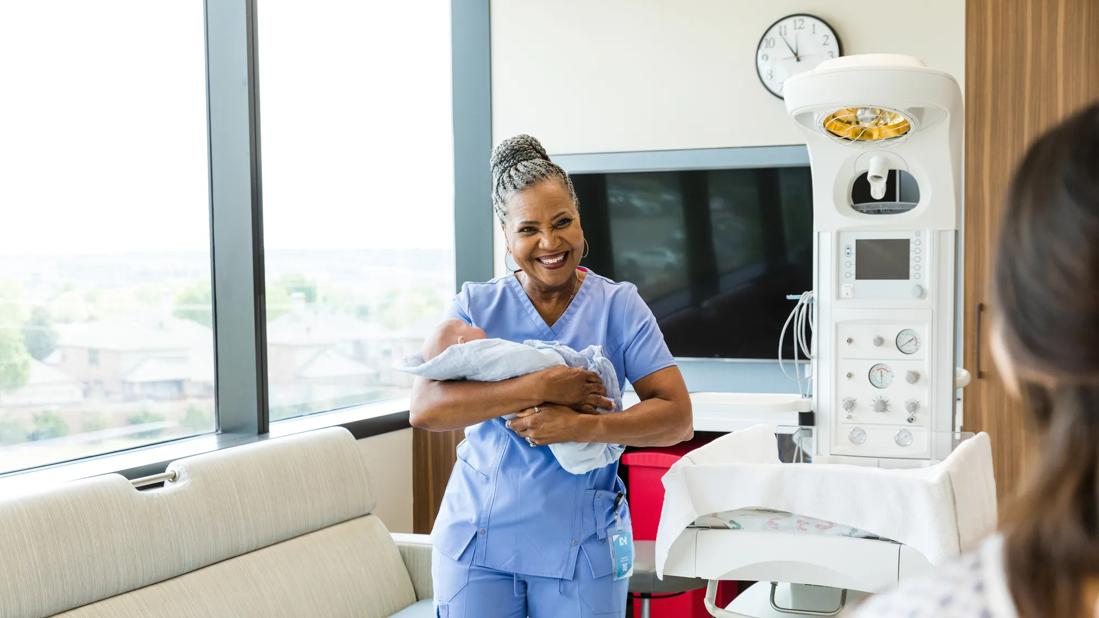Specialized unit provides patients with faster, more targeted care

Pregnant women faced with unexpected medical emergencies can now turn to a specialized
emergency department (ED) for care. Cleveland Clinic Hillcrest Hospital has engineered a
leading-edge obstetrics (OB) ED specially equipped to assess and treat the unique complications that can arise during pregnancy.
Advertisement
Cleveland Clinic is a non-profit academic medical center. Advertising on our site helps support our mission. We do not endorse non-Cleveland Clinic products or services. Policy
Since opening in 2021, the seven-bed unit has served the needs of more than 5,600 women with conditions ranging from fetal-movement problems to hyperemesis, hypertension, preterm labor and bleeding. The goal, explains Nursing Director Diane Cleary, MSN, CMSRN, NE-BC, is to provide rapid, appropriate treatment that is focused on the well-being of both mother and fetus.
“Before we had this facility, our clinicians frequently had to leave the floor to care for obstetric patients in the regular ED, where the wait times could be unpredictable,” Cleary says. “It became clear that we needed a specialized unit — a facility designed to meet the complex needs of pregnant women with an emergency.”
Located within Hillcrest Hospital’s labor and delivery unit and one floor above the ED, the OB ED represents a new model of care, says Cleary. When pregnant women arrive in the primary ED, they are evaluated. Depending on their presentation, many will be taken directly to a dedicated OB area, where wait times are shorter, the staff is trained in obstetrics and women can be seen by a staff OB/Gyn practitioner.
Emergent conditions like trauma, chest pain, shortness of breath and known ectopic pregnancies are typically managed in the regular ED, and less-emergent issues, including hypertension and bleeding, are assessed and treated in the OB emergency unit.
“Our staff is unusual in that it includes OB RNs, a clinical technician and a full complement of OB providers,” explains Julianne Fruscella, RN, a labor and delivery nurse. “We’re all here because we love what we do. I think our patients recognize that we’ve created a safe environment specifically for them — a place that is uniquely prepared to address complications that can arise during pregnancy.”
Advertisement
Importantly, the OB ED also provides priority processing of medical tests performed outside the unit. “In the ED, patients must often wait ‘in line’ to undergo diagnostic imaging and receive their laboratory results,” she says. “That’s not the case in our unit. Our goal is to remove as many barriers as possible between our patients and the care they require.”
The unit’s equipment is also specialized. The beds, for example, are already outfitted with the stirrups required for a pelvic exam. This is in contrast to the general ED, where stirrups must be added to traditional hospital beds on an as-needed basis. Rooms in the OB ED are stocked with electronic fetal monitors — not standard equipment in the regular ED.
The result of this extensive preplanning is more-personalized care that is attuned to the needs of pregnant women, explains Fruscella. “Our training ensures that we keep patients’ pregnancies top of mind when prescribing medications or performing interventions,” she says. “We strive to balance primary care and obstetric concerns to ensure the best outcomes for the mothers and babies we serve.”
If patient surveys are any indication, the OB ED is succeeding in its mission. “We’ve received so much gratitude from our patients,” says Cleary. “Pregnancy-related emergencies can be incredibly stressful for families, and our caregivers recognize the importance of approaching each case with empathy. I think our patients can feel that compassion, and they’re thankful.
“Word about the unit has spread, so we’ve had women come to us from almost every ZIP code in Northeast Ohio and beyond. Our reach just continues to expand.”
Advertisement
“Our physicians, nurses and leaders work very well together and share a commitment to continuous improvement,” she adds. “We never stop thinking about how we can make emergency care better, safer and less stressful for our future mothers and their babies.”
Advertisement
Advertisement

ACOG-informed guidance considers mothers and babies

Psychological care can be a crucial component of medical treatment

A Q&A with Cara King, DO, MS, on the upleveling power of coaching

Surgical video highlights techniques for optimizing myomectomy

New guidelines let the patients steer the process

Embracing generational differences to create strong nursing teams

CRNA careers offer challenge and reward

An unexpected health scare provides a potent reminder of what patients need most from their caregivers